AUGUSTUS KOOPMAN ETAPLES Le Sidaner Tattegrain Lavezzari Roussel Chigot Berck

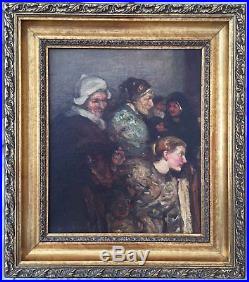
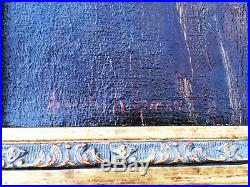
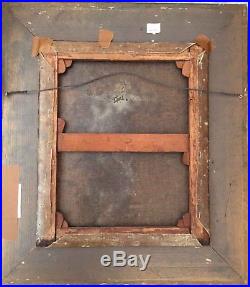
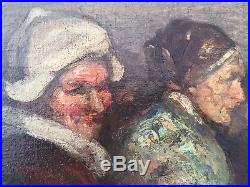

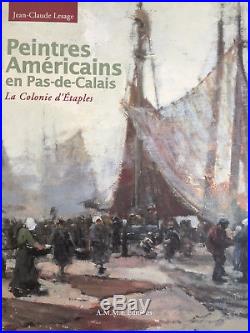
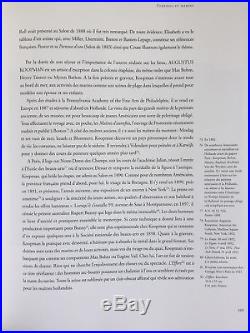
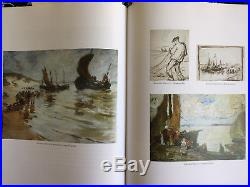
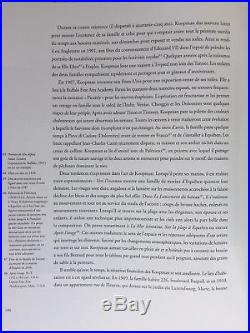
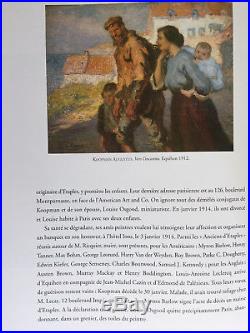
Artiste très coté et recherché (Artprice, Akoun, Artnet, Bénézit). Montre un groupe de matelotes sur le marché d’Etaples. On reconnaît notamment une calipette (bonnet traditionnel) et les grandes robes des femmes de l’époque. Rare sur le marché. Luvre doit dater vers 1910. Elle a été exposée au ” Isaac Delgado Museum of Art”, New Orleans, Louisiana, en mai 1912. Nous joignons le référencement de l’artiste dans le livre de Jean-Claude Lesage sur lÉcole d’Etaples et les peintres américains. Ce tableau est encadré avec une moulure dorée à la feuille d’or, bon état, quelques manques très légers, 66cm x 58cm de taille totale. Des tableaux similaires se trouvent dans les musées de Douai (Chartreuse) et de Le Touquet – Paris – Plage. Envoi sécurisé et assuré. Remise en mains propres à Lille sur rendez-vous. Certificat d’authenticité fourni (expertise commissaire-priseur). Je suis historien d’art et collectionneur d’artistes du Nord de la France. “Women in Marketplace, Etaples, France”. The work is in beautiful unrestored condition, oil on canvas, signed lower left. 18″ x 15″ (unframed). Exhibited: Isaac Delgado Museum of Art, New Orleans, Louisiana, May 1-30, 1912. Augustus Koopman, painter and etcher, was born in Charlotte. The son of Bernard and Johanna Koopman. After attending Central High School in Philadelphia, he began art studies at the Pennsylvania Academy of Fine Arts. Later he went to Paris, where he entered the École des Beaux Arts and studied under Bouguereau and Robert Fleury. On 6 May 1897 he married Louise Lovett Osgood of Cohasset, Mass. Koopman made France his home, wintering in Paris and spending the spring and summer in Étaples and in the nearby village of Équihen. He taught painting in Paris from 1896 to 1899 and specialized in portraits while in London from 1902 to 1906. Koopman has often been called a painter of emotionalism. He found inspiration in the ocean and its storms, disasters, and boats. Horses Running to Meet a Boat. Owned by the St. Paul Art Institute, is a notable representation of his subject. Are also full of movement and typify Koopman’s intense attraction to the sea. In contrast to these is. Return of the Shrimpers. Which depicts a quiet group making their way home from their boats. For this painting he received a medal in 1904 at the St. Louis Exposition and was invited to exhibit it at the Venice International Art Exposition in 1910. He was an exhibitor at Paris, Munich, London, Venice, and American exhibitions. His early work had many of the qualities characteristic of the modern Dutch artists, especially the marine painters Mesdag and Blommers. Later he became influenced by the impressionists and postimpressionists, and many of his pictures of this later period gained a unique popularity because of their individuality. Koopman’s works covered many themes. He was not essentially a marine painter; he was also a figure painter, using his own children as models. He painted a notable decoration. Government pavillion at the Paris Exposition in 1900. Are painted with great charm of pose and color. His drypoints and etchings were usually fishermen, scenes in cafés, and figures, all done in careful line. In 1912 Koopman was elected an associé of the Société Nationale des Beaux Arts. A great honor in the artist’s world, and he received many awards, medals, and prizes. Among these were the special silver medal for his decoration at the Paris Exposition, the bronze medals at the Pan-American Exposition at Buffalo (1901) and at the St. Louis Exposition, and a silver medal at the Appalachian Exposition at Knoxville (1911). His portraits and decorations are represented in French and American collections in St. Paul, and Detroit museums; the Philadelphia Art Club; and the Brooklyn Institute of Arts and Sciences. His etchings are represented in the Congressional Library in Washington, D. And there is a collection in the New York Public Library. He died of paraylsis in Étaples. La colonie artistique d’Étaples (en anglais : Etaples Art Colony), appelée aussi école des peintres d’Étaples , est un regroupement de peintres. Qui se sont installés, entre la fin du. Et le début du. Siècles, dans la commune. Située sur la Côte d’Opale. Dans le nord de la France. Le peintre Charles-François Daubigny. Précurseur de l’impressionnisme. Choisissait déjà ce lieu pour son inspiration et comme refuge après la chute du Second Empire. Une colonie d’artistes s’y forme à partir de 1882, et s’y maintient jusqu’en 1914. Après quoi elle s’est disloquée du fait de la Première Guerre mondiale. Largement internationale, elle a été constituée principalement d’anglophones d’Amérique du Nord, d’Australie et des îles britanniques, mais aussi d’Allemagne et de Scandinavie. Alors que certains artistes se sont installés dans la région, d’autres n’y sont restés qu’une saison, ou un temps encore plus court. Certains venaient de colonies artistiques installées le long des côtes de la Normandie. Et de la Bretagne. D’autres, tout proches, du Touquet. Ou le long de la Canche. Ainsi que de l’arrière-pays, depuis Douai. Le Salon de 1888 à Paris, fut particulièrement représenté par ces peintres où plusieurs de leurs uvres furent exposées. L’exposition universelle de 1893. Inaugure un pavillon des artistes de dimension international, de nombreux peintres français y furent invités, notamment par le biais de créateurs américains installés dans cette région : cette manifestation, très médiatisée, assure le rayonnement de la colonie. En mars 1900, la galerie Georges Petit. Inaugure à Paris la première exposition de la « Société nouvelle des peintres et sculpteurs » comprenant un certain nombre d’artistes installés dans cette ville. On ne peut les regrouper en tant que postimpressionnistes. Car ces artistes ne présentent pas, en fin de compte, d’uniformité de style, mais ils avaient plusieurs intérêts communs : culturels, recherche de la lumière, du calme, et il y eut aussi un effet de mode. Alors que la plupart des peintres ont quitté la ville en 1914. L’activité artistique, de qualité variable, a été poursuivie pendant la guerre par des bénévoles et les artistes mobilisés sur le front tout proche la ville fut d’ailleurs bombardée en mai 1918. Avec le retour de la paix, certains anciens résidents sont rentrés chez eux, et la persistance d’une petite colonie a attiré quelques visiteurs, mais peu de travaux innovants y sont apparus. L’item “AUGUSTUS KOOPMAN ETAPLES Le Sidaner Tattegrain Lavezzari Roussel Chigot Berck” est en vente depuis le dimanche 19 août 2018. Il est dans la catégorie “Art, antiquités\Art du XIXe et avant\Peintures, émaux”. Le vendeur est “prestigeartgallery” et est localisé à/en LILLE. Cet article peut être livré partout dans le monde.
- Authenticité: Original mis en vente par lartiste
- Caractéristiques: Encadré
- Type: Huile
- Quantité unitaire: 1
- Courant artistique: Ecole américaine / française
- Genre: Impressionnisme
- Thème: Personnage
